Blog SEO Series : Planning search optimised content
SEO is the art of getting your content to rank higher in search results, and attracting the user’s attention when it appears.
In this post, we’ll talk about optimising your content. With the right planning, your pages can find new customers and convince them that you can meet their needs.
SEO (search engine optimisation) is a broad field. Google’s algorithm is incredibly nuanced, and subject to constant changes. Factors that affect search performance cover not only your content. Your website’s design, code quality and reputation are all taken into account.
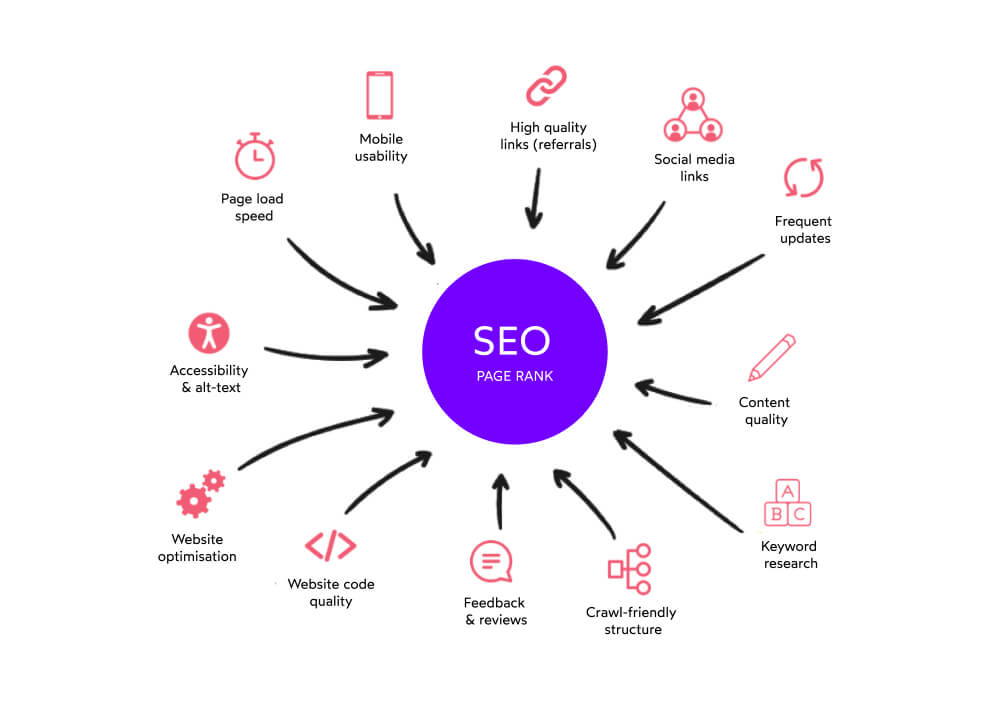
When talking about SEO, we usually split Google page ranking criteria into these three areas…
- Content. Is the information purposeful, and does it answer the user’s questions?
- Code. Is the website meeting web standards for code quality, accessibility and speed?
- Reputation. Is the website linked to from other reputable sources, who have a good search ranking themselves?
Staying on top of everything is tricky.
There’s a lot to think about, so writing a comprehensive guide to SEO in a single post would be nigh impossible. That’s why this is the first of planned series of articles covering some of the SEO fundamentals. We’ll talk about the tools and techniques we use in our own work at Pixel Fridge.
Let’s start with content
It’s no secret that when it comes to creating effective websites, content is king. Good content turns visitors into customers, which is the primary goal for most site owners. We need high quality, engaging content that responds to user needs.
This isn’t only a principal of SEO. It applies more broadly to user experience design in general. After all, shouldn’t every website be useful and serve a purpose? Google thinks so. That’s why content quality is one of the most important considerations for search rankings.
In this post we’re going to focus on content, and what good looks like. We’ll talk about how to write content that meets user needs, planned around terms that people actually search for.
What are SEO keywords?
A keyword is a term or phrase that a user may search for. If we want to appear in the Google search results for a keyword, then it ought to appear somewhere in our content. This is why keyword planning is such an important stage of online content creation.
Keywords can written into any part of the website content. A certain amount of this will happen naturally when writing content. We’ll use the terms our users are familiar with, without thinking too much about it.
That said, Google gives more ranking emphasis to keywords in prominent positions. Think page titles and headings. That is why we need to be tactical when writing content, to make sure we’re emphasising the most useful SEO keywords.
Types of search keywords
When it comes to SEO keywords, there are two main types.
- Branded keywords are terms that specifically refer to your own brand or company. An example would be ‘Pixel Fridge’. These also cover the branded products and services you provide.
- Organic keywords are the non-branded terms that both you and your competitors would love to appear for in search. An example for be ‘London Digital Agency’.
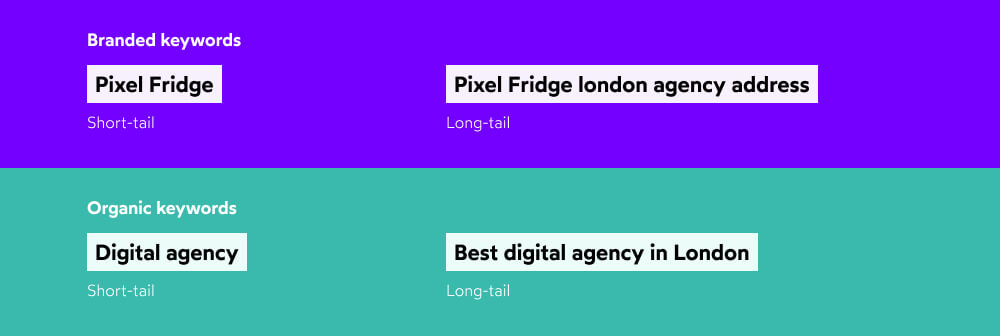
In most cases, we don’t need to overthink our branded keywords. This is because they don’t tend to be competitive. You can usually rest assured that when searching for your own brand, you’ll come out on top. In the majority of cases there is little value in optimising for branded keywords, since these tend to take care of themselves.
Naturally, there are some exceptions. Branded keywords are more important if…
- Your brand name is a fairly common term used often in different contexts by other companies.
- Competitors are making an attempt to poach your traffic using your brand name in their copy.
- You’ve been subject to some negative PR, and undesirable articles or reviews are appearing in the top search positions for your brand terms.
These are all totally valid scenarios in which we’d want to optimise our content for branded keywords. This is rarely the case for our clients, though.
If we were to look at the search engine performance of most organisations, we would see that the majority of users find them for brand-related search terms. But if users are only ever finding your site for branded terms, it means they already had you in mind when they searched.
The biggest opportunity lies with people who have a need – but aren’t already aware of your organisation. That’s why organic keywords are so important. They allow a whole new audience to discover your brand.
When it comes to the structure of keywords, we can further classify them as being either…
- Short-tail keywords are simple, more generic terms. An example would be ‘digital agency’.
- Long-tail keywords are more complex phrases, often containing modifiers, or phrased as questions. An example would be ‘who is the best digital agency in London?‘
Whilst we need to consider both kinds, it’s the long-tail keywords that need the most attention in our planning. That’s because longer terms will naturally be more relevant to the content on our page. People who find our content using very specific search terms are more likely to fit within our target audience. By extension, they’re more likely to convert once on the site.
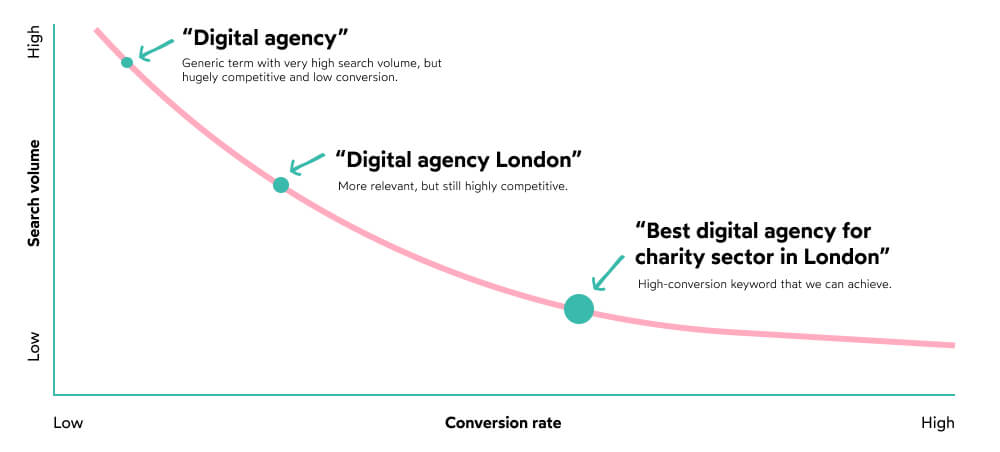
It’s not just the conversion potential, either. The more specific our keywords are, the less competitive they’re likely to be. This gives us a better chance of grabbing the top spot for those choice keywords, if we optimise our content for them.
Part of the content planning process is all about finding the sweet spot between relevancy, search volume and competitiveness.
Writing for user needs
So which keywords should we be using in our content? That’s the million dollar question. But it’s one that we can answer with a combination of research and strategy.
As you might expect from any reasonable piece of content, it should consider the needs of those who read it. In the early stages of website content planning, we usually create a user journey map that considers the mindset of our audience. Throughout the various stages of the user journey, we think about…
- Tasks. What has brought this person to the website?
- Questions. What are they likely to be asking, and how would they articulate it?
- Pain points. What are the issues they are trying to resolve?
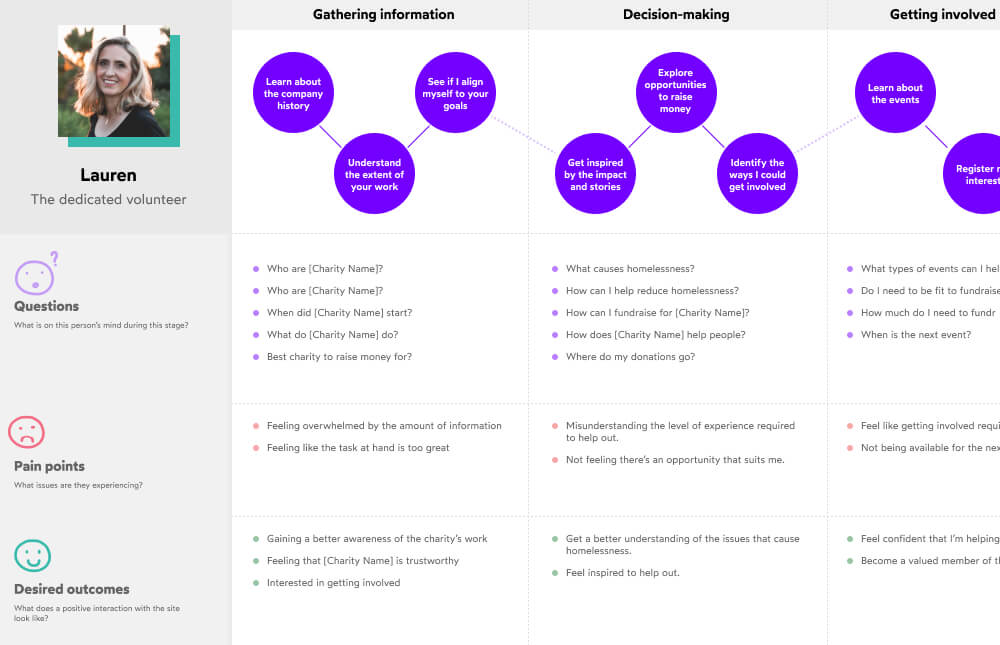
Armed with a journey map, we can begin shortlisting possible search keywords that correspond to each journey stage. If we want to get even more specific, we can break keywords down further into individual user needs. That depends on how many pages we expect the site to have, and how detailed the content will be.
When drafting a shortlist of keywords, consider variations and alternative terms that person might use when searching. Remember that at this stage we’re just shortlisting potentials. We haven’t landed on exactly which keywords we’ll use in our final content.
Keyword research tools
Coming up with keyword alternatives isn’t always easy. If we need inspiration, SEMRush’s Magic Keyword tool gives suggestions for keyword variations. It also give search volume data for each one. This means we can immediately get a better idea of the terms that are most often used by searchers. The Keyword Gap tool also allows you to see which keywords your competitors are going after.
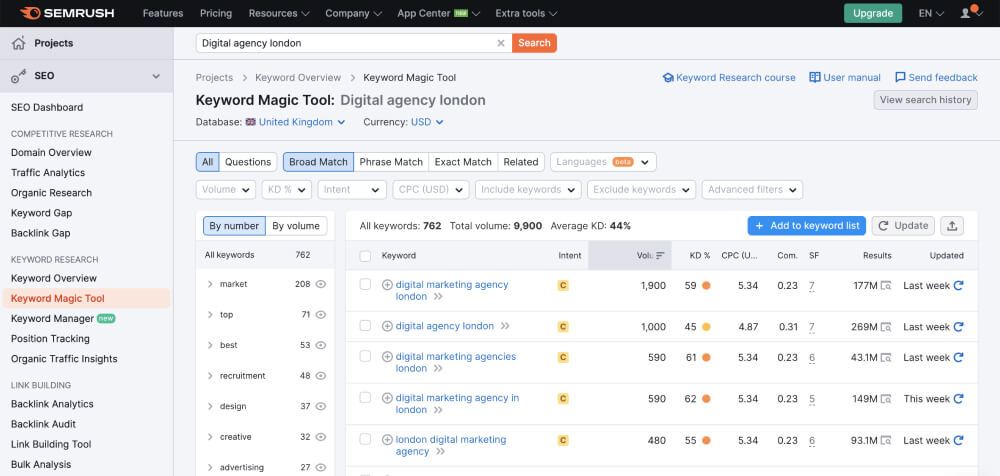
When selecting which specific keywords to include in our content, there are various factors involved. We of course need to consider any existing guidelines, or tone-of-voice documentation. But paramount to the SEO discussion is checking keyword performance.
There are a few different tools we can use to check the performance of a planned keyword. We’ve already mentioned SEMRush, which has a fantastic keyword overview tool. This tells us search volume and competitive density for a given phrase.
Another tool, MOZ, also offers a handy keyword explorer. This shows similar kinds of search volume data, and provides recommendations for adjustments or variations.
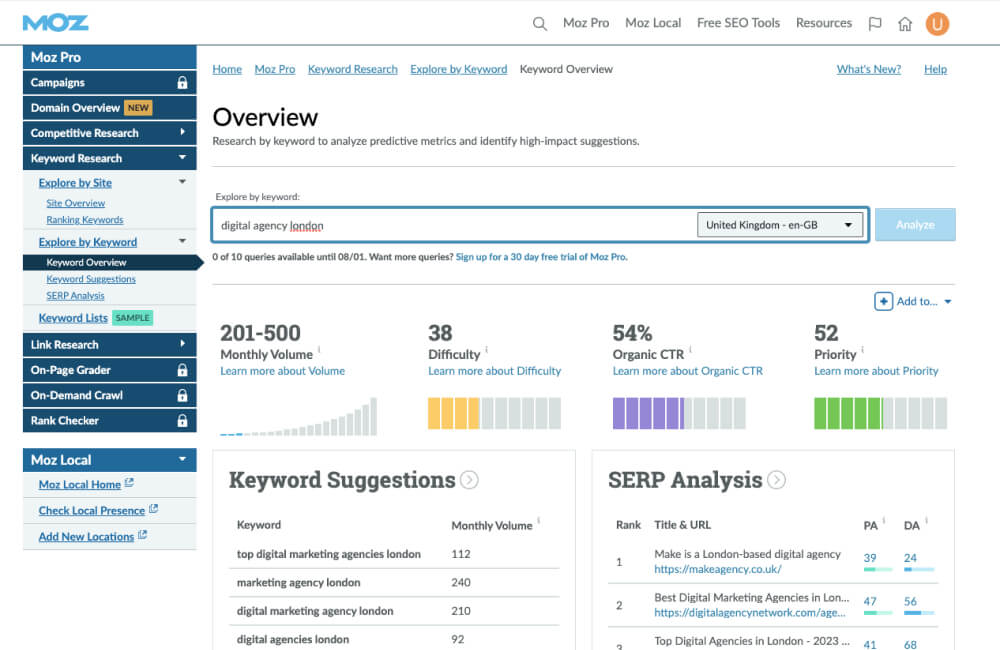
Both of these tools are fairly intuitive. They can help you judge how often people search for a keyword, and how many competing sites are already targeting it.
Choosing the right SEO keywords
There’s no magic formula to represent a ‘good’ ratio of search volume versus competitiveness. The numbers vary greatly from industry to industry. As you’re researching different possible terms, you’ll soon get a feel for what feels like the right balance, and where the opportunity lies.
Once we’ve decided on the keywords we’re using, we can start incorporating them into our actual page content. In the early stages of content development, we usually create a content plan spreadsheet. This outlines every page that will be on our site. We’ll note its purpose, the type of user it will be written for, and the all-important SEO keywords it should target.
The ‘head keyword’ is the main term we want to optimise this page for. It is best to have just one head keyword for each page, to keep things focused. It’s also the term that we’d suggest using somewhere in the page title. Page titles are super important for SEO. They’re so important that we’ll talk about them separately in their own post, later in this series.
Your content planning spreadsheet might also contain recommended headings to use within each page. These should be variations or alternatives to the main head keyword. The spreadsheet can then be used as a brief for the copywriter, who will create the text for the page.

Structuring content for SEO
When creating in-page content we should always write for humans, instead of getting too focused on the Google algorithm. So long as we’re using our target keyword in some prominent places, our objective should otherwise be to write clear, high quality content that helps the user.
When it comes to writing text for the web, there are some general best practices. Sticking to these principals will have the dual benefit of making your text more easily readable, whilst also boosting your google ranking.
- Use clear headings and subheadings. Use a clear hierarchy of headings to break up the information. These headings are where you should use the target keywords, if possible.
- Write short paragraphs. Stick to the rule of ‘one point per paragraph’. Breaking things up not only helps keep the user focused, but it also assists search engines with interpreting the messages in your content.
- Put the strongest points first. The most important sentences should appear at the start of a paragraph. Make the point quickly, and follow on with the more in-depth information.
- Write in structured lists. If you’re making a list of points, use a bulleted or numbered list. Don’t use long ‘walls of text’.
- Include links to your other pages. If your content references topics that you’ve written about elsewhere, make sure you link to those pages.
- Write descriptive links. The clickable links in your content should describe what you’re linking to, and never just say ‘click here’.
Measuring SEO success
Our work doesn’t end after hitting the publish button. To be sure that decisions around content and keywords were the right ones, we need data for our search engine performance.
Get into the routine of checking content performance using analytics tools like Google Analytics or Matomo. These will show you how often each of your pages is discovered through organic search results, versus other channels. Equally important is whether users engaged with the content, and went on to convert…. Or if they immediately closed tab after clicking through.
We can get further insights into our search performance using Google Search Console. It is not only beneficial for your search performance to have this set up, it also provides helpful information. Search Console will reveal around how often your pages are appearing in Google searches, and for which terms. It will also reveal the click through rate, telling us how often a page is selected from the list of results. This data is the most accurate way to judge how successful our content and keyword planning has been.
Like most other areas of digital product development, the work is never truly done. There is always scope for improvement. Make sure you’re routinely checking your analytics, and revisiting content that isn’t performing optimally in search.
Content trends, along with the terms that people use change constantly. That’s why it’s often necessary to rewrite content to keep it modern, and ensure that we continue to stay revenant. This applies not only to the keywords we’re targeting, but also to user needs our content serves in a broader sense.
Thinking about ‘meta content’
When it comes to SEO, content really is king. But there’s much more to it than just the words on our pages. There’s also the ‘meta content’. This is the information we publish behind the scenes to help search engines understand and index our pages.
In the next post in this series, we’ll get into best practices for meta content. Specifically we’re going to talk about writing high quality page titles and meta descriptions. Stay tuned!
Chris Myhill
— Director of Experience